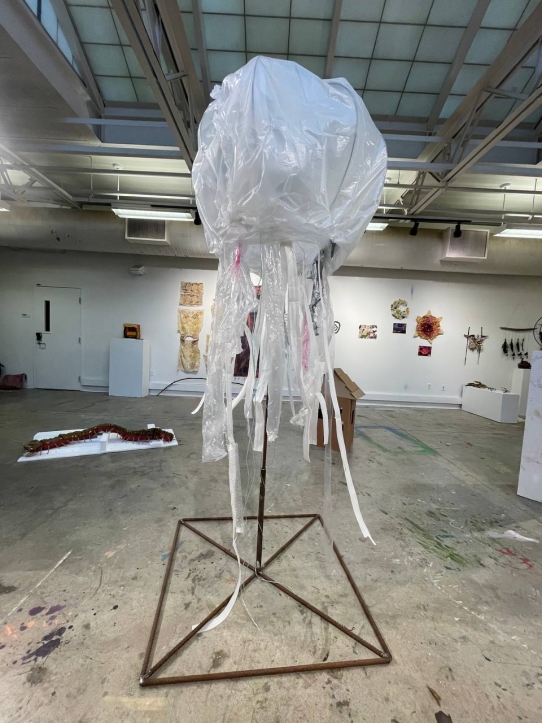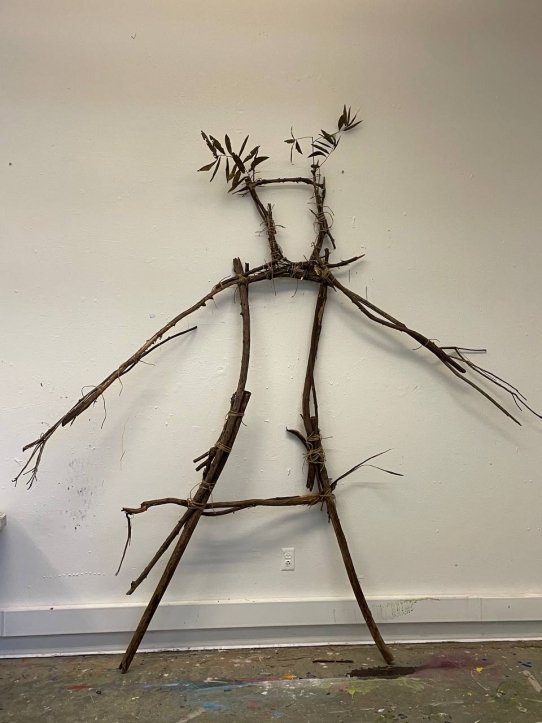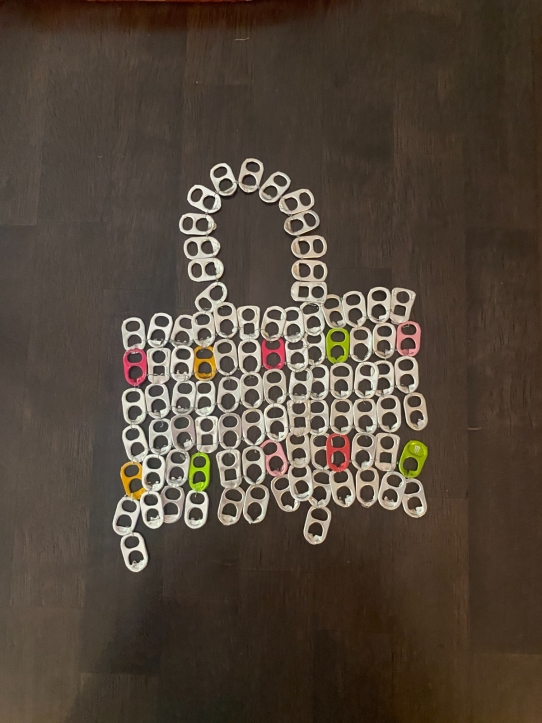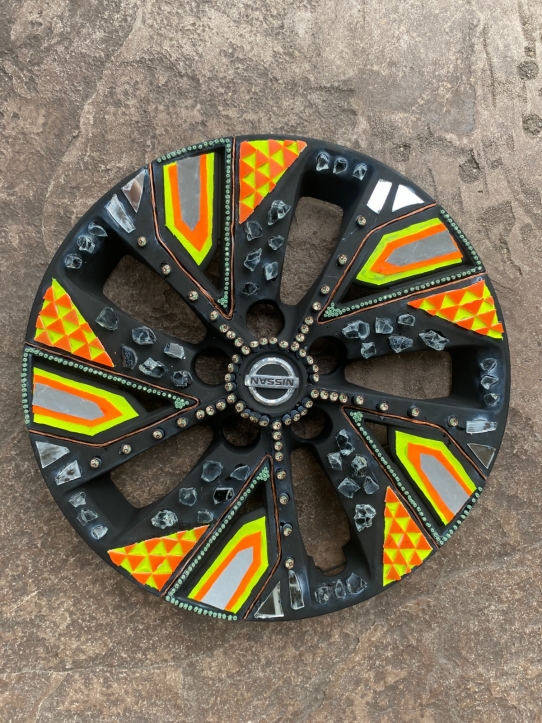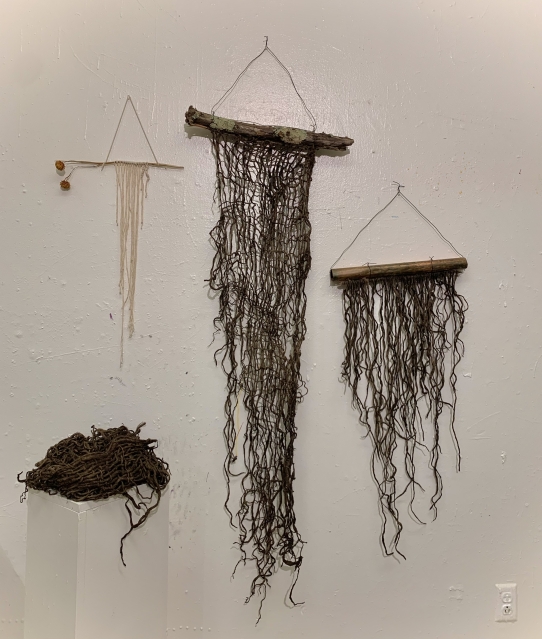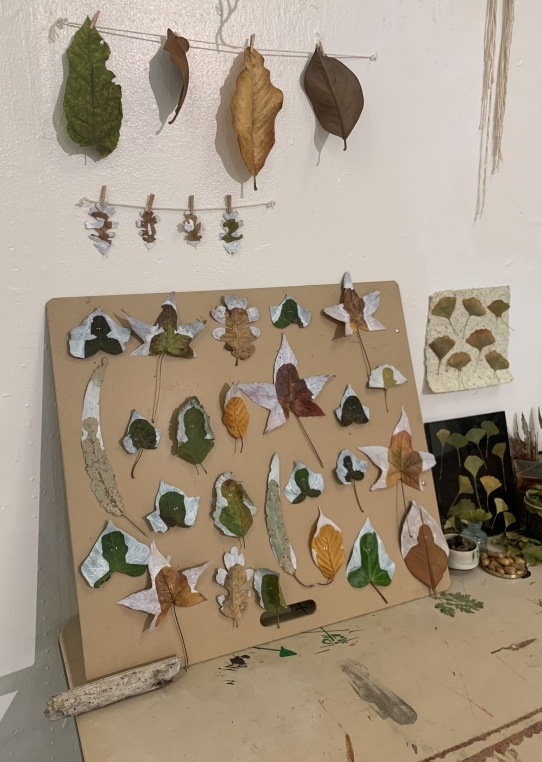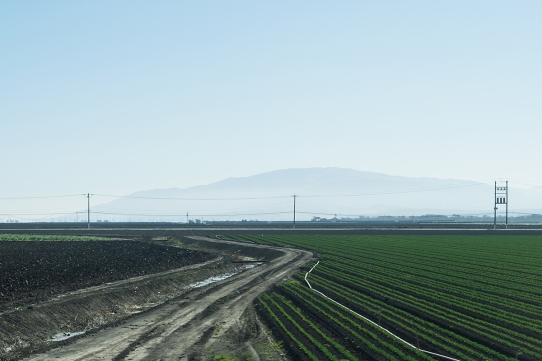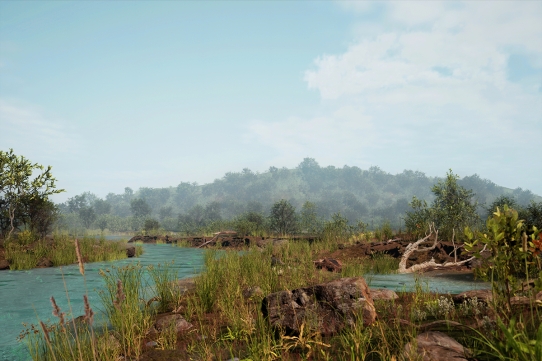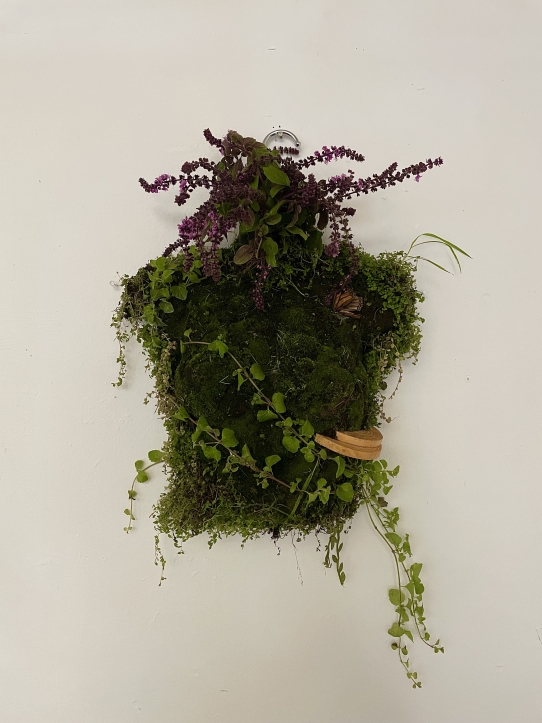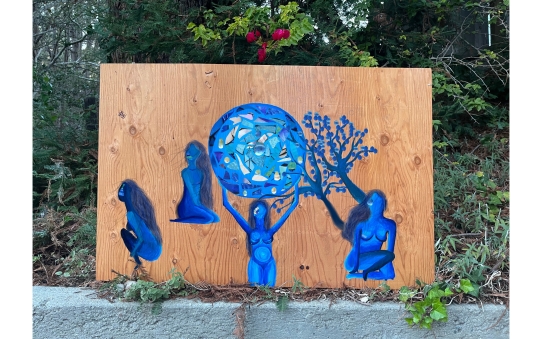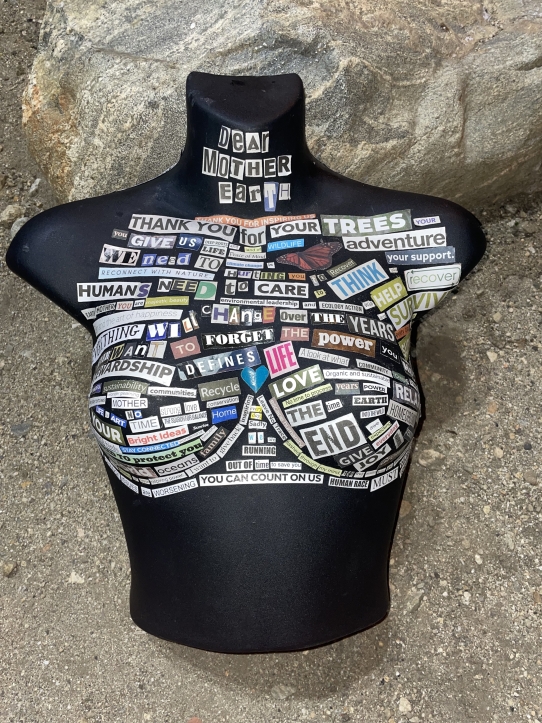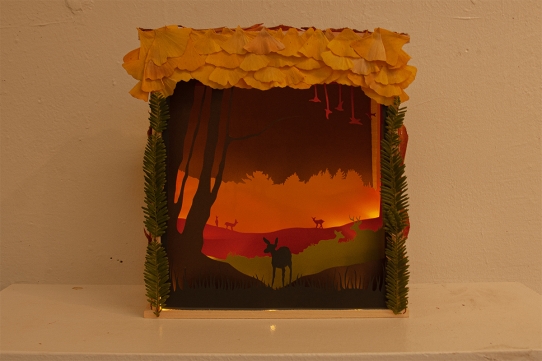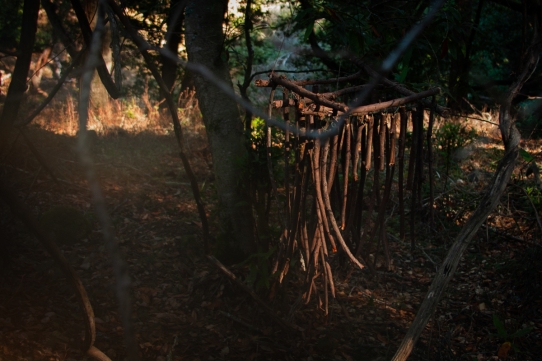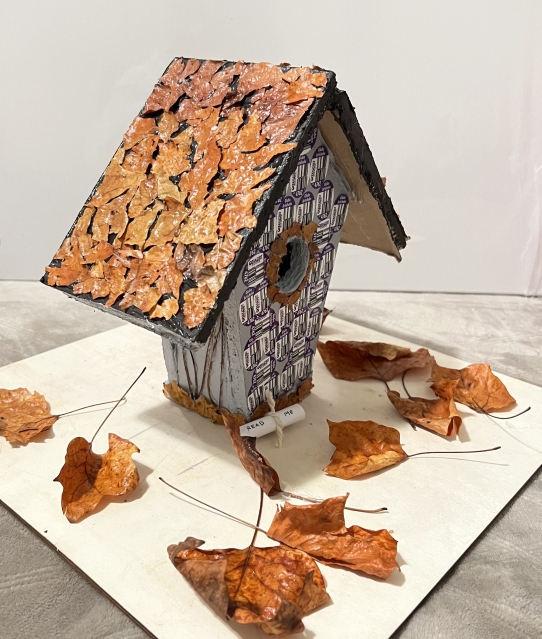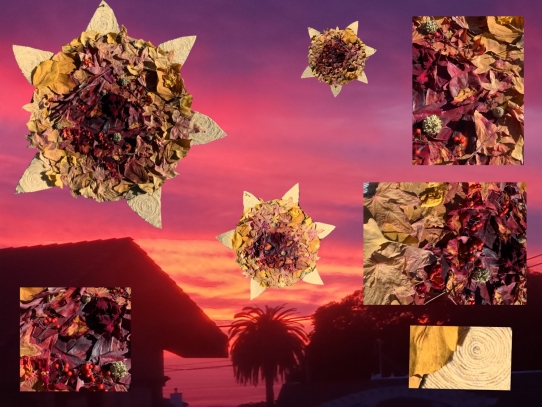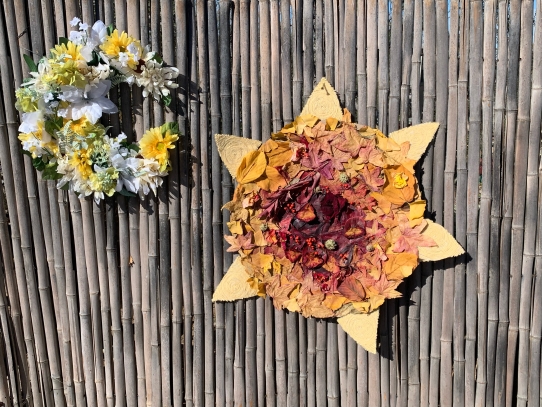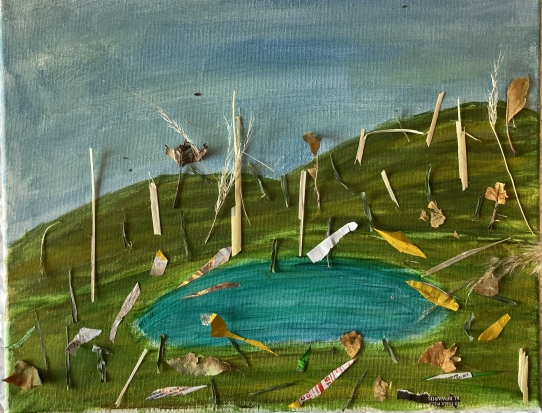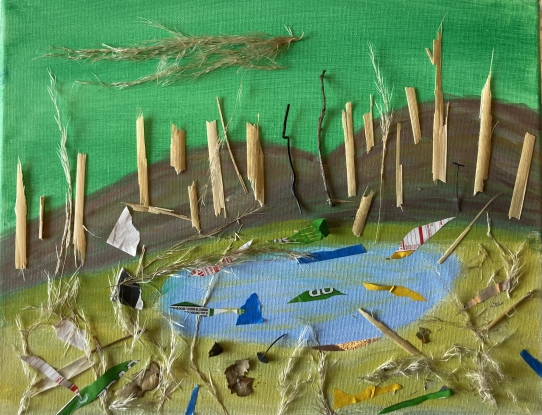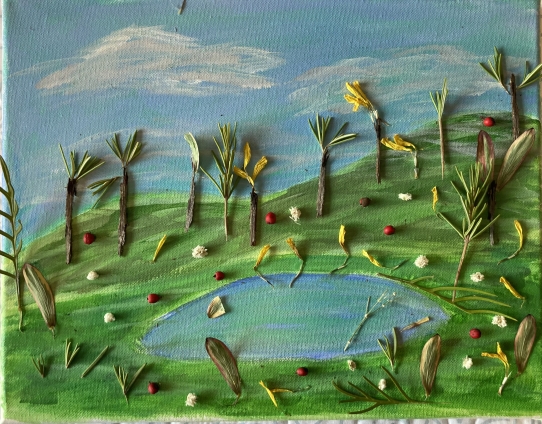Virtual Open Studios Fall 2022 - ART 125 Environmental Art Studio
Instructor - Edward Shanken
Alex Yu
“Untitled”
Welded steel rods, plastic
For this piece, I was inspired to make a jellyfish out of plastic that I collected from the trash. I wanted to both repurpose, and also mimic the way in which marine life often confuse jellyfish with plastic floating in the ocean. I welded the base and the frame, and decorated it with plastic.
“Untitled”
Sticks, jute
For this piece, I wanted to make frames to hang in nature to reflect that our natural world is art, and that we just need to look at the world through a different lens. As I constructed the individual frames, they began to take an anthropomorphic shape, and I decided to make a human figure. I tied sticks together with jute, with the intention of putting the figure back in its natural environment to decompose over time.
Brennan Elliott
Delaney Stewart
dirt yarn
cotton string, copper, dried globe amaranth flowers, wood
I created three assorted wall hangings made from detritus and natural materials. The dirt yarn material was sourced from UCSC’s redwoods forest by Mchenry library. I wish to showcase that we, as a community, have the ability to reuse and repurpose waste and detritus to create beautiful wall art and decor. In doing so, this project stands to challenge consumerist culture and capitalistic desire by owning the means of production and sourcing the materials from local environments and their pollutants. Through the combination of natural and organic presenting manufactured materials, a compelling visual narrative is crafted about origins, everything we make, consume, and create comes from the Earth. I hope my project inspires others to create, and attune themselves to our surroundings in order to utilize, cleanse, and harbor respect for the natural environment.
ginkgo biloba (2022)
shredded ginkgo leaves, glycerin, water
ginkgo biloba (2022) exhibits the beauty and medicinal properties of Ginkgo Biloba. Known for supporting memory and cognitive health, I set out to make a tincture in hopes of extracting it. I chose to approach this project by showcasing not only the natural beauty of the plant but its form as a tincture. My project itself is composed of two pressed ginkgo leaf arrangements, a gingko biloba tincture decorated with its leaves, a diffuser of the grounded leaf's scent, and a basket filled with leftovers from the harvest.
ART125 FALL 2022 LEAF YEARBOOK
maple, ivy, ginkgo, and magnolia leaves + acrylic paint
Through this project, I wanted to recognize the power an individual has in impacting the future of our Earth. I decided to make a class yearbook out of natural materials to show that we are one with nature and that all of us have the ability to impact it. I made stencils of each student’s silhouette within Environmental Art and painted the leaves using acrylic white paint. This piece serves as a way to recognize each of our individuality and, though our existence is impermanent, our actions and decisions can have a lasting impact on the world and future generations.
Evan Robel
This project explores how humans have transformed the Earth. It specifically focuses on how the central valley of California has been destroyed by the agricultural industry. I learned about how extensive this destruction was only about a year ago while on social media. I was motivated to make this project because I found it interesting that even though I have been in the California school system for 17 years I was never taught about this. My goal with this project is to promote change. My hope is that the harsh contrast between the pieces titled “Past” and “Future” will motivate viewers to want an Earth similar to how it looked 500 years ago rather than what it will look like if we continue on this path.
Evan Robel
“Present”
This image is a photograph of farmland in Salinas valley. I wanted to capture how much the land has been shaped by humans to fit our agricultural needs.
Evan Robel
“Past”
This image is a digital rendition of what I think my photograph titled “Present” used to look like around 400 years ago. I want this image to show how wild and biodiverse this area used to be. I created this image using Unreal Engine and Photoshop.
Evan Robel
“Future”
This image is a digital rendition of what I think my photograph titled “Present” may look like around 200 years in the future. I want this image to show what will happen to the landscape if we continue to treat the Earth the way we do today. I created this image using Unreal Engine and Photoshop.
Grace Bologna
Earth Women
Used mannequin body covered in live moss, plants, flowers and a dead butterfly.
Earth Women displays the beauty of nature and its interconnectedness with the human
The Four Sisters
Used wood slab, paint, shattered glass and tile materials
The four women represent winter, spring, summer and fall. Not only are womanly features often represented within nature, women's bodies replicate seasonal changes similar to how nature shifts throughout time. Women's bodies and the natural environment both experience physical changes and seasons that carry out continuous cycles. The tiles and glass also display a type of cycle, as the bits and pieces are used again instead, being recycled instead of discarded.
Grace Bologna
Letter to Mother Earth
Used mannequin, recycled newspaper and magazine clippings
Mother Earth is all powerful, she is the reason why all beings can live and survive. Throughout the years, human beings are destroying her. The Letter to Mother Earth, demands change within society in order to preserve nature.
Hannah Rouland
"Community"
Wood, paper lights, found leaves
This shadow box, inspired by the deer at the Elena Baskin Arts campus, adorned with leaves found in the environment, depicts the seemingly separated layers of an environment that, despite seeming isolated, compliment one another to create a community in the environment.
"Presence"
Wood, string
This projects compiles found sticks to create an abstract representation of my hair, mimicking my presence in a nature setting that I desire to both belong to and disappear in.
"Presence2"
Wood, string
"Altar to Adolescence"
Found materials
This shrine uses items found through thrifting and personal storage to honor an adolescence I seek to provide offerings to and receive aspects of joy, as well as a lack of shame from.
Itzel Rios
“Home in a Home”
Mixed media 11”x 7”
This bird house is composed of sheet rock, leaves, stickers, and paper.
“Seamed Up”
Mixed media 24”x 18”
This is a landscape portrayal made with old clothes displayed with a put together rag in a hamper.
“Env Proj. 2 Upcycled Birdhouse”
This video gives background information of how I created my birdhouse “Home in a Home”.
Matilda Krulder
“Dual Impressions”
Cyanotype on Canvas Drop Cloth and Branches
This piece creates two impressions of a ground space using 1 hour exposed cyanotypes and naturally sitting vines and branches. It is an exploration of shadow, light, space and negative space contained within a single site.
“Dual Impressions” in front
“Pillow on a Stick” in back
Cyanotype on Canvas Drop Cloth and Branches,
Ecoprints on Deconstructed Silk Pillow Case
Pillow on a stick begins to bring nature into intimate spaces.
“Mommy Earth part 1”
Ecoprints on Deconstructed Silk Blouses and Cyanotype on Found Silk Scarf
This project is a facet of my exploration of my sensual and intimate relationship with the environment. It is heavily influenced by my discovery of and research into ecosexuality. Large inspiration is drawn from the work of Beth Stephens and Annie Sprinkle.
Mayari Crolene
Art has always been a significant way of communication in my life, expressing changes I go through, emotions I feel, and how I perceive the world. I find my peace through creating and I have learned how the pieces I create can cause a positive influence on other people's emotions and views on the Universe. I find meaning in creation, and I fully believe my reason for existing is bringing light into the world through my work. I find much of my inspiration comes to me from music and other artists' art. I like the freedom to express how I feel and push some sort of message to observers. My motive is to make people wonder, think, and come up with answers and their own meanings they see in my piece that might not necessarily be what I was attempting to express, but it means something to them, and shows the way they think and perceive the world around them. I view people, nature, animals, all non sentient beings, items, and the intangible all as one. We are all the universe, we all are connected, we are all art.
“Araw”
Recycled materials, dried leaves, dried flowers, and berries.
This piece is constructed from leaves I gathered all across the California coast. From Santa Cruz, Paso Robles, Santa Margarita, and Santa Barbara. I gathered these fall leaves and arranged them into a gradient of colors. The leaves I attached slowly hardened and became crisp and fragile. I had to be more gentle with the artwork as time went on and some of the leaves started to flake and chip off. This makes me think of how the Earth is, becoming more fragile with time due to humans. It became a significant correlation I kept being reminded of and thinking of while I crafted the piece. The rose petals, berries, and acorns I found became potpourri. It was interesting to see the change while it was attached to the art piece. The point of it is to be impermanent and show how mother nature springs to life, matures, decays, and dissipates into energy for other life forms.
“Buwan”
Recycled materials, dried leaves, dried flowers, and berries.
Here is the moon part of the project. Everything here in this is manmade. It’s fake, the flowers are pretty but they will remain like this for decades, even in the landfill or if they get thrown and littered these fake flowers will never die or go away...ever. They supply nothing to the environment nor do they supply energy to other living beings. The moon too will eventually become just like the stars, trash. But this also shows how artificial things and trash can become something beautiful! Making this project has made me rethink a few of my carbon footprint practices. How I as an individual create waste that can and will outlast my own life. I will make a bigger effort to preserve our planet and not make it fragile like the leaves on my project. And I will continue to look at trash not as a burden, but as an opportunity to do better and stimulate creativity and imagination.
“Araw and Buwan”
Recycled materials, dried leaves, dried flowers, and berries: Araw. Fake flowers, leaves, and recycled materials.
Here are both pieces together.
Nestor Ruelas
Nour Gabsi
Melanie (Yijun Zheng)
In and Out (2022)
flowers, leaves, chalk, charcoal, pepper powder
I conducted an experiment with a series of motions and recorded them by video. First it appears to be two footprints with various plants on them. Then human feet step on them and step away three times. Noteworthily, every time the feet are smeared with powder or pinter of different colors. The colors serve as tokens for the marks and influence imposed by humans on our planet. Eventually, all the traces were washed away by the tide and suddenly the ground became clear as if nothing had happened.
This work brings up and explores a couple of open questions. For instance, what is civilization? What does it mean to be human? Is civilization a gift or a disaster? Where exactly are we humans and the civilization directing? What will nature be like then? For all these controversial questions, I've made my own way through reflection and action.
nature? (2022)
photos of polluted and exploited nature, sanitary pad, hanger, drawings of femininity on the body with red paint
I used photos of what human beings have done to nature, for example, the mine strip, the indication of deforestation, and the melting iceberg. I stuck them to the area of my breast, as to present my body as the ground of nature. Besides, I asked my classmate Alex for help drawing some symbols of traditional femininity on my body, which represent the oppression of patriarchy. (The hanger on my hair stands for abortion in my own perspective) In this way, my body also embodies the victim of exploitation by the patriarchy.
nature? (2022) explores the correlation and the tension between women's bodies and nature. The female body has always been related to or portrayed as nature, however, it is in this seemingly spontaneous and instinctive way that the exploitations begin and persist for long. And this is just the same thing that we take for granted when it comes to the utility of the natural world. This project is supposed to inspire more reflections on our current masculine world and more revolts against that.
a burnt corset on a man’s body (2022)
A burnt fabric, locker, covid-19 self-test box, o photo of Urumqi road sign
Through this project, I did this performance to show my support for the recent protests in my country. Over the weekend, fury over pandemic lockdown measures that have continued for nearly three years rapidly developed into one of the boldest displays of dissent against Chinese authorities. Later on, several big cities and prestigious universities witnessed strong responses from young people. They launch the A4 Revolution, in the form of holding blank sheets of A4 white paper, as a token for the ban to speak and post by censorship. This has been really symbolic across social media and among young people.
I’m mightily touched and appealed by those strong words, slogans, and emotional outbursts. Some brave people I know have taken part in the protest and I feel it’s a pity that I can’t stand in person with them. So I literally want to stand in solidarity with them and participate in this protest in my own way.

